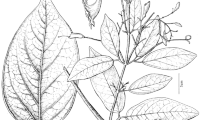Abstract.
A characteristic xeromorphic foliage occurring in the European Tertiary was originally identified as a Proteaceae according to gross morphology, and compared with Grevillea L. and Lomatia L. (Grevillea kymeana Unger, Lomatites aquensis Saporta). On the basis of venation patterns and phyllotaxy, these elements are now reinterpreted as extinct species of Berberis L. (Berberidaceae): Berberis andreanszkyi spec. nov. occurring in the Upper Oligocene (Eger – Wind brickyard), and the Middle Miocene (Erdbénye) of Hungary, and Berberis kymeana (Unger) comb. nov. (syn. Lomatites aquensis Saporta) known from the Lower Miocene of Greece (Kymi) and the Oligocene of France (Aix-en-Provence, Manosque/Bois d'Asson, Cérestre, Bonieux). The associated vegetation reflects warm-temperate to subtropical subhumid climatic conditions. Extant barberries with similar foliage occur in the Himalayas and China today.
Similar content being viewed by others
Author information
Authors and Affiliations
Additional information
Received April 3, 1999 Accepted September 25, 2000
Rights and permissions
About this article
Cite this article
Kvaček, Z., Erdei, B. Putative proteaceous elements of the Lomatites-type reinterpreted as new Berberis of the European Tertiary. Plant Syst. Evol. 226, 1–12 (2001). https://doi.org/10.1007/s006060170069
Issue Date:
DOI: https://doi.org/10.1007/s006060170069




